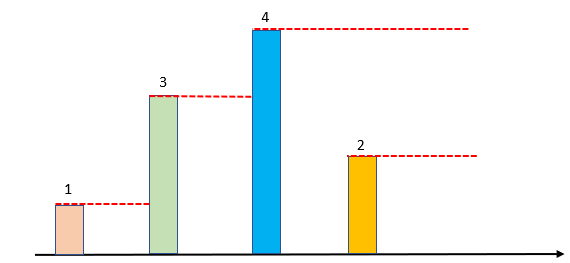Table of Contents
Problem Statement
Next Greater Element I Leetcode Solution – The next greater element of some element x in an array is the first greater element that is to the right of x in the same array.
You are given two distinct 0-indexed integer arrays nums1 and nums2, where nums1 is a subset of nums2.
For each 0 <= i < nums1.length, find the index j such that nums1[i] == nums2[j] and determine the next greater element of nums2[j] in nums2. If there is no next greater element, then the answer for this query is -1.
Return an array ans of length nums1.length such that ans[i] is the next greater element as described above.
Example 1:
Input:
nums1 = [4,1,2], nums2 = [1,3,4,2]
Output:
[-1,3,-1]
Explanation:
The next greater element for each value of nums1 is as follows: - 4 is underlined in nums2 = [1,3,4,2]. There is no next greater element, so the answer is -1. - 1 is underlined in nums2 = [1,3,4,2]. The next greater element is 3. - 2 is underlined in nums2 = [1,3,4,2]. There is no next greater element, so the answer is -1.
Example 2:
Input:
nums1 = [2,4], nums2 = [1,2,3,4]
Output:
[3,-1]
Explanation:
The next greater element for each value of nums1 is as follows: - 2 is underlined in nums2 = [1,2,3,4]. The next greater element is 3. - 4 is underlined in nums2 = [1,2,3,4]. There is no next greater element, so the answer is -1.
Constraints:
1 <= nums1.length <= nums2.length <= 10000 <= nums1[i], nums2[i] <= 104- All integers in
nums1andnums2are unique. - All the integers of
nums1also, appear innums2.
Follow up: Could you find an O(nums1.length + nums2.length) solution?
Approach
Idea:
- we make a map to store every element’s next greater element
- to find the next greater element in nums2 we maintain a monotonically increasing stack
- to do this we traverse the nums2 array from (n-1 to 0 where n is the size of nums2)
- if the stack is not empty, then compare its top element with nums2[i]
- if the nums2[i] is greater than stack’s top element, then we pop from stack while (!st.empty() && st.top()>nums2[i] )
- now if we find an element in the stack then we store it in the map
otherwise, we store -1 in the map - now we push nums2[i] into the stack as it might be the next greater element for elements ranges b/w (i-1 to 0)

C++ Program of Next Greater Element I
class Solution {
public:
vector<int> nextGreaterElement(vector<int>& nums1, vector<int>& nums2) {
map<int,int> mp;
stack<int> st;
for(int i=nums2.size()-1;i>=0;i--)
{
while(!st.empty() && st.top()<nums2[i])
st.pop();
if(st.empty())
mp[nums2[i]]=-1;
else
mp[nums2[i]]=st.top();
st.push(nums2[i]);
}
for(int i=0;i<nums1.size();i++)
{
nums1[i]=mp[nums1[i]];
}
return nums1;
}
};Java Program of Next Greater Element I
class Solution {
public int[] nextGreaterElement(int[] nums1, int[] nums2) {
Map<Integer, Integer> mp = new HashMap<>();
Stack<Integer> st = new Stack<>();
for (int i=nums2.length-1;i>=0;i--) {
while (!st.isEmpty() && st.peek() < nums2[i])
st.pop();
if(st.isEmpty())
{
mp.put(nums2[i],-1);
}
else
{
mp.put(nums2[i],st.peek());
}
st.push(nums2[i]);
}
for (int i = 0; i < nums1.length; i++)
nums1[i] = mp.getOrDefault(nums1[i], -1);
return nums1;
}
}
Complexity Analysis for Next Greater Element I Leetcode Solution
Time Complexity
O(n+m) where n is the size of nums1 and m is the size of nums2
Space Complexity
O(m) as we use a map to store every element’s next element and stack to find the next greater element